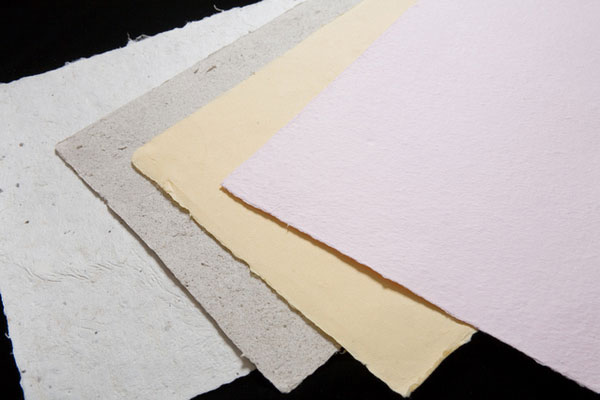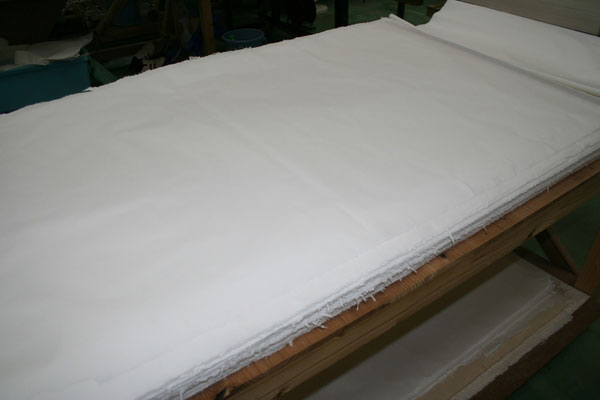
- Traditional Japanese paper
- Tottori
Inshu traditional Japanese paper Inshu washi
1300 years of tradition
the finest, softest and most durable texture
Description
What is Inshu traditional Japanese paper ?
Inshu washi is a handmade traditional Japanese paper made in the former Inaba province, the eastern part of Tottori prefecture. The most famous type of paper is a textured drawing paper that is ideal for calligraphy and ink painting, boasting high domestic production. Mulberry, paperbush, and gampi are the quintessential raw materials of Japanese papermaking. Inaba province is blessed with an abundance of forests and beautiful clear streams which are used for the production of this craft. Inshu paper is versatile for having a soft and flexible texture while also possessing a natural durability. It is commonly said that because this paper is so soft, brushes write twice as fast as on other Japanese papers, and also results in the absorption of less ink. This is expressed in an old adage, "a brush fortunate enough to only write upon Inshu paper will never be low on ink".
The papermaking process uses abundant flowing water. The splashing sound from pulling up wet pulp from a water tank is such a traditional sound that the Ministry of the Environment has designated it as one of 100 Selections of Soundscape in Japan*. In response to changing consumer demands, new products such as three‐dimensional interior crafts or computer printing paper have been introduced, but with time-honored traditional techniques still used.
*The 100 Selections of Soundscape in Japan is a list of sounds from every part of Japan, meant to encourage the preservation of both the natural environment and cultural heritage. Some examples of sounds are cicadas at Yamadera Temple or the Awa Dance Festival.
History

Inshu traditional paper has a long historical tradition. The Shosoin monjo seishu, preserved in the Shosoin Repository*, are a major series of famous ancient manuscripts dating back to the Nara period (710-784) that includes the ancient seals of Inaba province. The Engi-Shiki Code, which was completed in 927, records the province as offering paper to the Imperial Court.
From the Edo period (1603-1868), a manuscript written by Kamei, a feudal lord, states that pulpwoods like paper mulberry and gampi are “trees prohibited from being cut”. Also Inshu washi was widely used both as tributes to the Tottori domain (present day Tottori prefecture) and for general use in society. In the Meiji period (1868-1912), bleaching techniques and more efficient manufacturing methods were introduced, and production kept increasing until the end of the Taisho period (1912-1926).
In the Showa era (1926-1989), the industry experienced a downturn in demand because of the spread of wood pulp paper. After the Second World War, craftsmen focused on utilizing traditional techniques for new product development such as papers for calligraphy and dyed papers. Notably, papers for ink painting achieved the largest market share in Japan and increased the brand recognition of Inshu paper.
*The Shosoin Repository is a building located in Nara, a former capital of Japan, that has been around since the eighth-century. It not only has a collection of treasures dating back to the Silk Road, it also preserves over ten thousand hand-written documents all dating from the Nara period. Today the repository is under the control of the Imperial Household Agency.
General Production Process

- 1. Raw materials
Paperbush, paper mulberry, and gampi are the major raw materials of Inshu washi. After cutting, materials are selected depending on the final product, and soaked in water for some time. Impurities like sand and dust are washed out and the outer black bark is gently stripped off with a knife.
- 2. Boiling
The pulpwood bark contains plenty of cellulose, as well as other substances, and must be boiled to release the long fibers required for papermaking. The bark is soaked again to soften. A steel vat is filled with water, and before boiling, plant matter such as bamboo, straw or hemp, as well as chemicals like caustic soda or soda ash to alkalize the brew are mixed in. The boiling time, generally two to three hours for paper mulberry, varies according to the kind of raw materials and the alkalinity levels. The brew releases a distinctive sweet aroma during this process.
- 3. Washing and bleaching
Boiling helps the solution, made of pectin and lignin, needed to connect bark fibers to dissolve in the water more easily. The fibers are washed again to get rid of any unnecessary material or remaining solution. Finally, the fibers are washed and rinsed in a clear stream to remove remaining imperfections and any impurities are picked out carefully by hand.
- 4. Beating
Beating further breaks down the once joined together fiber tissues. This thorough softening encourages the pulpwood fibers to more easily entwine with each other during papermaking, which will affect the strength and durability of the final product. Fibers subject to a low level of beating will make paper with a rough texture and low density. Nowadays, beating is done by hand or a machine.
- 5. Papermaking
Although all the earlier preparation is crucial to Inshu papermaking, at the heart of this process is the sukibune water tank, and a sieve-like tool, the sugeta. Impurities are removed from the beaten pulp and the right degree of stickiness is achieved by adding a gelatinous mucus made from the roots of a sunset hibiscus plant.
The water tank is filled with water and pulp, and then stirred. The sieve is used to scoop up fibers and gently agitate them to help them entwine and settle into a uniform thickness. This process is called sukinagashi. Inshu washi is characterized by the endless repeating of these simple but highly skilled movements to ensure the desired thickness and texture.
- 6. Dehydration
The wet paper is left to dry, so as not to lose their shape. Several hundred sheets are piled up and pressure is applied gradually.
- 7. Drying
After compression, each sheet is carefully peeled off, stuck upon a board using a wide brush to remove any wrinkles, and left to dry in the sun or a drying room.
- 8. Cutting
Each sheet is checked for holes and flaws and then cut to standard sizes according to purpose, such as drawing or writing. This is often done by machine but the traditional hand cutting method, involves the simplest set of tools; a knife, a cutting board, a ruler and lots of ability.
Where to Buy & More Information
Aoya Washi Kobo

-
Address
-
Tel.+81-857-86-6060
-
ClosedMondays (open if Monday is holiday and closed the next day), December 29 - 31
-
Business Hours9am to 5pm
-
Website
See more Traditional Japanese paper
- Mino traditional Japanese paper
- Echizen traditional Japanese paper
- Tosa traditional Japanese paper
- Sekishu traditional Japanese paper
- Inshu traditional Japanese paper
- Awa traditional Japanese paper
- Ozu traditional Japanese paper
- Echu traditional Japanese paper
- Uchiyama Japanese paper































































































































































































































































































